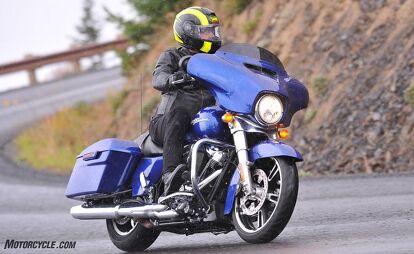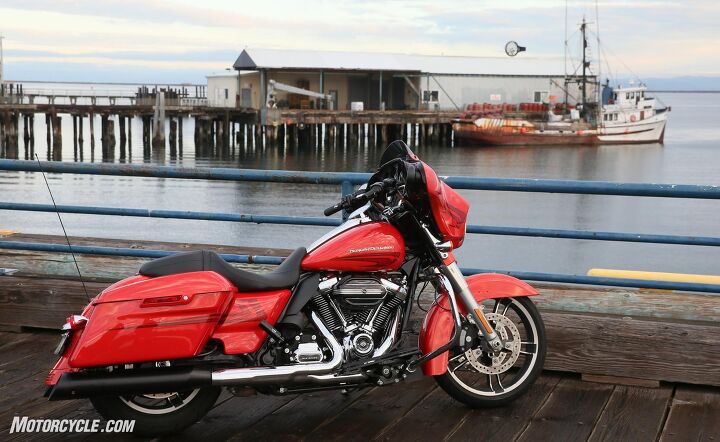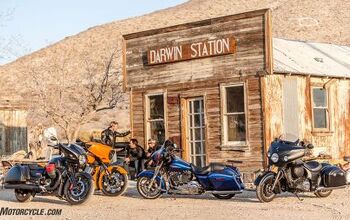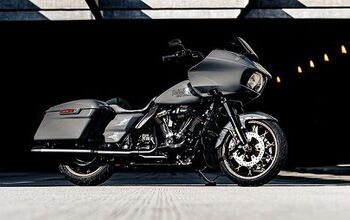2017 Harley-Davidson Street Glide First Ride Review

Since Harley-Davidson has updated the engines of its entire touring model line, we thought we should check in with an example of each of the three variations of the Milwaukee-Eight. For years, the Street Glide has been Harley’s best-selling model – and a favorite here at MO – making it a natural choice for sampling the base-model Eight’s 107ci engine. Still, the engine isn’t the only news involving pistons on the 2017 touring models. In a normal year, the upgraded suspension components on the Street Glide would be big news, but with motorcyclists being power freaks, the new engines are stealing the suspension’s thunder.
2017 Harley-Davidson Street Glide
| Engine | 18.5/20 |
| Suspension/Handling | 12.0/15 |
| Transmission/Clutch | 9.25/10 |
| Brakes | 9.0/10 |
| Instruments/Controls | 4.25/5 |
| Ergonomics/Comfort | 8.0/10 |
| Appearance/Quality | 9.0/10 |
| Desirability | 8.75/10 |
| Value | 6.0/10 |
| Overall Score | 84.75/100 |
2017 Harley-Davidson Milwaukee-Eight Engines Tech Brief
The beauty of the Milwaukee-Eight engine is that the Harley-cognizanti will be able to immediately tell that the Street Glide has the new 107 engine, while, to people with a more limited knowledge of the bike, will immediately know it is a Harley. The M-E takes the classic lines of the Twin Cam engine and makes them simultaneously more muscular and slimmer. While the Motor Company’s engineers say that the primary focus of the engine shapes was weight reduction (to allow for the increased weight of the new components in the engine), they also focused on maintaining and updating the Big-Twin’s iconic style. A quick look at the heads and the cam cover shows compound curves which hint at the shape of the components inside. The left side of the engine wears a narrower derby cover that remains unmistakably a Harley engine. The cylinders look similar but brawnier than the Twin Cam’s.
From the moment the engine starts, the M-E is clearly a different motor. First, it starts seemingly without effort, rather than with the first slow crank of old. Second, the engine revs easier and more quickly. However, the action that will put a smile on your face is rolling on the throttle. Throughout the rpm range, the Eight pulls much stronger than the Twin Cam ever did. In fact, when we reviewed the first Project Rushmore generation of the Street Glide, we wished from more power from the High-Output Twin Cam 103. The torque curve begins low and covers a broad swath of the rev range, delivering a claimed 111.4 lb-ft of twisting force at the crankshaft. Our dyno test of the 2014 Street Glide logged 92.1 lb-ft at the rear wheel. Since about 10% of the torque gets lost on its way to the rear wheel, we can surmise that the M-E produces about 100 lb-ft – or 8% more than the Twin Cam. The horsepower feels similarly enhanced, though Harley makes no claim about horsepower numbers.
2014 Harley-Davidson Street Glide Special Vs. Indian Chieftain
The assist clutch is easier to pull and offers plenty of feel for working the friction zone. While it can’t be called easy, the improvement is appreciated. Although the only change that was listed in the transmission of the Eight was removing the lash to eliminate noise in neutral, the transmission feels slightly more refined, shifting up and down smoothly. Throughout every ride, though, the engine character that shines out with equal impressiveness to the newfound power is the silkiness of the fuel metering. Any concerns over potential throttle abruptness at low rpm because of the larger 55mm Mikuni throttle body are negated within minutes of starting the first ride. No matter the riding conditions, the EFI delivers smooth throttle transitions and a linear feeling of attachment to the rich grip. The note from the 2-into–1-into–2 exhaust system is throaty and satisfying.
The other major change in the Street Glide comes in the form of new suspension components. The previous rear suspension used air-adjustable preload, but Harley’s research revealed that many owners never bothered to purchase the hand pump required to check and set the air preload, meaning that the preload was set during the bike’s initial dealer prep and never adjusted again. Air-adjustable preload functions much in the way that a tire does over time: air leaks out. So, riders were having their rear suspension’s preload disappear over time, resulting in the bike riding too low in the shocks’ stroke. Similarly, some riders saw the valve stem and hooked it up to an air chuck. Since the suspension was designed to hold a maximum of 50 psi, inadvertently adding too much pressure blew out the shocks’ seals and reduced the preload to zero.
2014 Harley-Davidson Touring Motorcycles Review
The left shock on the Harley’s touring models now features hydraulically adjustable preload. Now, the rider simply cranks on more or less preload, and it stays set, forever. Because the Street Glide features shorter shocks for a slammed look, the range of preload adjustability is now 15% larger than before. (Touring models with full-length shocks get a 30% preload range increase.) The owners manual lists numbers to dial in for different loads to make it easier for a rider to find appropriate preload for solo, two-up, or two-up with gear in the luggage. In addition to the new preload adjuster, the shocks use a larger, emulsion-style piston to damp the road forces than last year’s suspension.
The fork also received some upgrade love in the form of Showa’s new valve-bending technology. The large piston valve offers performance, says Harley, of a cartridge-style fork with less weight. The fork’s initial travel is firm enough to keep the tire in better contact with the road over smaller ripples, but the fork can flow the large amounts of oil required to absorb the big hits of potholes and other broken pavement. Although Harley was mum on the actual specifications of the front suspension, it looks like the same 49mm stanchions with better internals.
The result of the suspension upgrades is that the chassis feels more planted on smoother or slightly rippled pavement. The front feels more solid on turn-in, responding more firmly to the shift in weight. Big hits upset the front end much less, and the back, while still bottoming on occasion, feels much more adept at handling loads. When the shocks do bottom, the jolt is not as strong (read painful) as with the old suspension. One bonus change resulting from the new suspension is the refined ABS firmware to allow more aggressive response because the front tire is more firmly seated on the road.
Paul James, Director of Motorcycle Product Planning, asserts, “This will be as big of a deal to many of our customers as our new powertrain is, and together, when you combine this new powertrain with this all new suspension, the entire riding experience is dramatically enhanced.”
Aside from the new profile of the Milwaukee-Eight engine, the Street Glide is visually unchanged. The original hot-rod bagger still has its ubiquitous bat-wing fairing and lines that slope rearward. The saddlebags receive a small update. The old bag mounting system has been updated with levers that give positive feedback via detents on the turns of the screws.
The riding position is comfortably open with a slight reach to the grips extending the elbows to a little beyond 90° of bend. The seat is firm but not hard, and the feet reside on floorboards in a forward but not stretched out position with the heel-toe shifter within easy reach. The brake pedal, like in previous years, requires a fairly tight bend of the ankle if the heel of the boot is kept on the floorboard.
In two days of riding, the weather protection provided to the rider’s upper body by the fairing proved itself to be more than ample in the rain. The wind protection is free of buffeting at highway speeds, too. As you might expect, the rider’s legs are out in the open and would quickly get soaked if not wearing rain gear. The Rushmore-developed infotainment system offers decent sound at speed.
For 2017, Harley has given the Street Glide a major overhaul in the engine and suspension – two areas that would provide the most functional benefit to riders. The rest of the good news for 2017 is that the remainder of the Street Glide remains essentially the same, save for annual color updates. The 2017 Harley-Davidson Street Glide begins at a $20,999 MSRP and is available for test rides at dealerships, now. Even if you’re not really in the market for a new bike, it’s worth taking a test ride to sample the Milwaukee-Eight engine to see what a big change it makes to the motorcycle.
2017 Harley-Davidson Street Glide
+ Highs
- Milwaukee-Eight engine’s broad torque curve
- Impressive EFI tuning
- Much improved suspension
– Sighs
- Brakes could use a little more power
- No cruise control An editor who doesn’t verify his memory by checking the manufacturer’s spec sheet
- Rained too much on the introductory ride
2017 Harley-Davidson Street Glide Specifications | |
|---|---|
| MSRP | $20.999-$21,499 |
| Engine Type | Air-cooled, 45° V-Twin |
| Displacement | 107ci (1746cc) |
| Bore and Stroke | 99.999mm x 111.125mm |
| Fuel System | Electronic Sequential Port Fuel Injection (ESPFI) |
| Ignition | Electronic |
| Compression Ratio | 10.0:1 |
| Peak hp | NA |
| Peak Torque | 111.4 lb-ft (claimed) |
| Transmission | 6-speed |
| Final Drive | Belt |
| Front Suspension | 49mm conventional fork |
| Rear Suspension | Dual emulsion-style shocks, hydraulically adjustable preload on left shock. |
| Front Brake | Dual 320mm, four-piston calipers |
| Rear Brake | 320mm, four-piston caliper |
| Front Tire | 130/60-19 |
| Rear Tire | 180/65-16 |
| Rake/Trail | 26° / 6.8 in. |
| Wheelbase | 64.0 in. |
| Seat Height | 27 |
| Measured Weight | 830 lb. (claimed) |
| Fuel Capacity | 6 gallons |
| Available Colors | Vivid Black, Black Denim, Superior Blue, Velocity Red Sunglo |
| Warranty | 24 months |

Like most of the best happenings in his life, Evans stumbled into his motojournalism career. While on his way to a planned life in academia, he applied for a job at a motorcycle magazine, thinking he’d get the opportunity to write some freelance articles. Instead, he was offered a full-time job in which he discovered he could actually get paid to ride other people’s motorcycles – and he’s never looked back. Over the 25 years he’s been in the motorcycle industry, Evans has written two books, 101 Sportbike Performance Projects and How to Modify Your Metric Cruiser, and has ridden just about every production motorcycle manufactured. Evans has a deep love of motorcycles and believes they are a force for good in the world.
More by Evans Brasfield














































Comments
Join the conversation
You didn't have any buffeting at highway speeds? I've test ridden the SG (a few different times to give it a chance), and get terrible buffeting already at 45-50mph, with a full face helmet. I tried with my face shield open and closed, and with the vent on top of the fairing open and closed.
Been riding 35 years and now i got my eyes on the 2017 street glide. Anything i should know before i spend my cheddar on this bike im used the evo or older engines what sup withese new motors